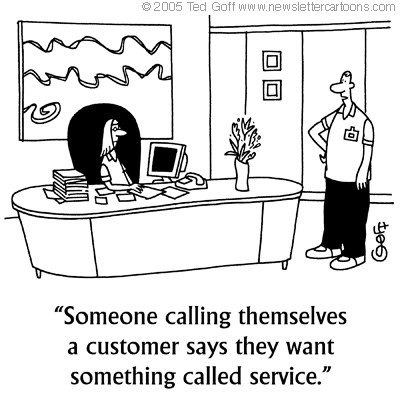Chapter 1: Defining Customer Centricity
Chapter 1 Learning Outcomes
After reading this chapter, you should be able to do the following:
- Define the term “customer service”.
- Define the term “customer experience”.
- Define the term “customer journey”.
- Define the term “customer centricity”.
- Discuss how changes in consumer behaviour affect how companies serve customers.
- Discuss how technological advances affect how companies serve customers.
Customer Service
Customer service is the assistance and advice provided by a company to customers throughout the customer journey; before, during, and after the sale. Humans usually provide customer service to other humans, but some service comes from machines, technologies, animals, etc. The service a customer receives becomes part of the experiences they have with the company.
For example, if you purchase a product and need to return it because it is missing a part, you might drive to the store, get the product out of your back seat, put it in a cart, wheel it into the store, visit the return counter, speak with an employee about your return, and so on. You may even phone the store before driving there. In this example, your perception of the company and your experience with the company will be based on many factors:
- Availability of parking
- Availability of carts
- Wait time in the line-up at the return counter
- The manner in which the employee speaks to you at the return counter (courteous, professional)
- The efficiency of the employee implementing the return process (equipment, cash)
- The manner in which the employee speaks to you on the phone (courteous, professional)

Now, imagine that you did phone the store before driving the product back to the store for a return and refund. You explained that there was a missing part to the staff member on the phone. The staff member on the phone at the return counter informed you that many customers have had this same issue and that the manufacturer is able to send you the missing part by express delivery, free of charge. As well, the manufacturer will include a small gift, an accessory item for your product, due to the inconvenience. Will you now decide to keep the product? You may or may not, but you will feel that the information the customer service representative shared with you over the phone was valuable and you will appreciate that they did so. This touch-point, over the phone, is an experience that should leave you with a positive view of the manufacturer and the retail store, even though the manufacturer made an error by not including one of the parts in the first place. Would your perception of your experience have been negative if the representative on the phone did not share this information with you, and you found out only after you had driven all the way to the store and stood in the return line for some time? Most likely it would not be as positive as hearing this information before you put in the effort to return the product. That is why it is so important for leaders and managers to build a culture of customer centricity, train employees, build standards and measure performance pertaining to customer service. Companies need to retain customers to stay in business, and you need to help the company retain customers to stay employed.
A final note about the scenario above, the retailer is actually a customer of the manufacturer (product supplier or vendor); therefore, the manufacturer also has the desire to keep the relationship positive with their customer (the retailer). If the manufacturer did not satisfy the retailer’s customers by offering a free replacement part with express shipping, the retailer’s customers would become angry at the retailer (the place they purchased from). If this situation occurs often, the retailer will most likely search for a different product supplier or at least stop purchasing that product from that specific supplier. So, it is not only important to keep individual customers happy in business-to-consumer sales (B-2-C), but it is also important for businesses to keep their business customers satisfied in business-to-business sales (B-2-B).
In subsequent chapters, you will learn about providing customer service in both a face-to-face retail environment as well as in a contact center environment, and about managing customer service teams and customer service technologies.
Watch the “Poor versus Great Customer Service” YouTube video below for an example of what bad service looks like compared to good service.[1] Transcript for “Poor vs Great Customer Service” Video [PDF–New Tab]. Closed captioning is available on YouTube.
Customer Experience (CX)

Customer experience is the result of an interaction between the customer and the company. It is how customers perceive their interactions with the company or brand. A customer touch-point is a point in time when the company connects in some form with the customer (e.g., website, phone, email, social media, retail store, returns, service, and products). There are many different customer touch-points, for example, when a customer phones the contact center for support, when a customer first visits the company website to review its products, or when the customer visits the store. The customer will get an impression of the company from each of these interactions. If the store is unclean or the products are difficult to find or the staff are rude this could leave the customer with a negative impression of the company and they might perceive the store in a negative way, thus, having a negative customer experience. The customer’s perception IS the customer’s experience.
Companies work hard to create a positive experience for customers, but things do go wrong at times, and some customers will perceive that the company has not met their expectations in some way, thus, leaving those customers with a negative impression or perception of the company.
Over time, as the customer has more and more experiences with the company, these experiences may shape the customer’s perception negatively or positively, and too many negative experiences will most likely cause the customer to discontinue engaging with the company; they will visit a competitor’s store instead.
Explore the Concept – Customer Experience (CX)
Consider the following questions:
- When shopping or eating at a restaurant, what might occur that would cause you to have a negative customer experience? What might occur that would cause you to have a positive customer experience?
- What were your expectations when you entered the establishment? Did the company meet your expectations?
- If you visited this restaurant twice and had positive experiences both times, but then on the third visit you had a negative experience, would you return a fourth time?
- What would you suggest as three “best practices” for creating a positive customer experience?
There is a popular saying, “a company is only as good as its people”. This statement refers to the need to hire good people, train employees, and create a positive corporate culture. When the employees are happy working for the company they will most likely do their best work to help the company provide positive experiences to customers. Of course, while the interactions your employees have with customers are a large part of the customer experience, other factors are also important.
Customers have certain expectations of service and what they experience with the company, for example, when you shop at a Dollar Store (e.g., Dollarama, Dollar Tree, Dollar Store, Dollar Shop, etc.) you probably expect low prices and do not expect that every product the company sells is of high quality and comes with a warranty. You might expect those things from Apple, BMW, Harley Davidson, or other company that is known for high quality and prestige. From a dollar store, you expect the store to be clean and the products arranged in a manner that makes it easy to find the products you are looking for. You expect prices to be low. You probably expect the staff to be helpful, friendly, and professional. If for example, you walked into the store and the lights were not working, it might upset you, or if it was the middle of winter and the store had no heat, you might not shop very long. If the products were not on the shelves and there were boxes blocking the aisles, you might become annoyed.
What if you had received poor service at the store, the store was a mess, the cash register was not working the day you visited the store, and you could not find the product you wanted in stock? What would you do or say to the staff? What would you think about the store? Would you shop there again? Would you tell your friends about the poor experience you had? Most likely, you would not go back, you would think the store was not professional, you would not shop at that location again, and you would probably tell your friends and family what a bad experience you had there.
Organizations that do not improve their customer experiences through improved customer service, improved customer journeys, and improved customer centricity will not stay in business long in today’s global and technological world. Consumers can go online and buy whatever they need and want quickly and easily. Consumers can switch to a competitor, in most cases, with little risk or switching costs. Consumers today are savvy. They research and learn about products they want before they buy and they expect much from the organizations they patronize.
Customer experience (CX) is the new marketing battlefront. More than two-thirds of marketers responsible for CX say their companies compete mostly on the basis of CX, according to the 2017 Gartner Customer Experience in Marketing Survey. And in two years’ time, 81% say they expect to be competing mostly or completely on the basis of CX.[2]
Customer Journey
The customer journey is the complete sum of experiences that customers go through when interacting with a company and its brands. It considers the complete path from brand discovery to purchasing and beyond. The focus is not on purchases made, but rather on how the customer feels about the interactions throughout their journey with the company.
In building a customer-centric business, personas and customer journey maps are important strategic tools that help provide an in-depth understanding of who a company’s customers are, what they need, and how they interact with the company across all touchpoints.[3] These tools help to share customer insights across the organization and can be critical for building employee buy-in and helping teams take targeted action to improve customer experience.
Personas are fictional customer types created to represent real target customer groups. They are more than generalized customer segments because they have individual names and stories that reflect personal attributes and behavioural characteristics such as customer needs, motivations, and attitudes. For example, a company may target Reza, a college professor, in their mid-40s, a parent of three teenage children, shops online due to time constraints, orders delivery from restaurants a few times per week, enjoys exercise, eats vegan, etc. The company creates these personas to help them better understand all the needs of their target customers, which in turn helps them provide products, services, and processes that will meet or exceed the customers’ expectations.
Once a company fully understands the lifestyle and demands, responsibilities, attitudes, and desires of their target customer; they can map the customer journey. Mapping the customer journey will allow the company to identify where they may not be serving the customer to the best of their ability so they can make improvements to the customer experience.
The customer journey map is a visual depiction (diagrammed or written) detailing the path the customer takes from the time the customer first discovers the brand, to purchasing, and beyond. The customer journey map examines the full experience of being a customer with the company and examines all touch-points and channels.
A customer journey example:

Tom is shopping online for a new car (website touch-point). He decides to phone a car dealership to ask about a vehicle he saw online (phone touch-point). Tom is greeted in a friendly manner and has all his questions answered by a salesperson (employee touch-point). Tom makes an appointment and comes to the dealership to test-drive the vehicle he is interested in (location/organization touch-point). The salesperson, Jordon, who Tom spoke with on the phone greets him, answers his questions, demonstrates a friendly and professional manner while dealing with Tom, and sends him out on a test drive (employee and product touch-points). Tom decides to purchase the vehicle and Jordon completes the paperwork, processes the sale and payment, and offers to deliver the vehicle within two days (employee and company policies/practices touch-points).
Jordon assures Tom that the vehicle comes with warranties, and should Tom change his mind about the purchase, he may return the vehicle within the first 30 days no questions asked (employee, manufacturer, and company policy touch-point). Jordon asks if Tom would like to register for a loyalty program whereby Tom will receive emails on future promotions and receive gifts for referring others (if they purchase a vehicle too). Tom is interested and Jordon gathers Tom’s email. Jordan provides Tom with a $100 gas card as a thank you gift for purchasing the new vehicle (employee and company policies touch-points). Later in the week, Tom tweets a picture of himself standing in front of his new vehicle and he mentions the dealership and the excellent service he received from Jordon. He even recommended the dealership on dealerrater.ca. A few months later, Tom feeling loyal to the dealership, and remembering the loyalty rewards program, refers a friend to Jordon at the dealership.
It is important to create many personas and scenarios because every customer’s journey will be slightly different. It is also important for companies to talk to customers (and employees) to learn more about the customer journey and experiences customers have. Creating personas and customer journey maps will help organizations identify poor service issues so they can take action to improve their customers’ experiences.

Customer Centricity
Customer centricity is a way of doing business that fosters a positive customer experience before, during, and after the sale in order to drive repeat business, build customer loyalty (which leads to customer referrals), increase business growth, and gain a competitive advantage.
A customer-centric company is more than a company that offers good customer service. Anytime a customer-centric business makes a decision, it deeply considers the effect the outcome will have on its customers. An organization that forgets about customers is destined to fail. They will build the wrong products, invest in the wrong resources, and lose goodwill with customers.[4]
Customer-centric organizations identify their most valuable customers and ensure their satisfaction. These organizations focus on ensuring employees understand how important customers are to the company. Often the organization’s mission, vision, and values include a customer-centric focus as more and more companies see a need to build relationships with their customers. Based upon the company’s mission, vision, and values the company aligns goals, distributes resources, develops products and services, defines processes, and develops strategies for competitive advantage.
Markets have moved from product centricity to customer centricity. Companies used to focus on design, manufacturing and logistics and in the past when products and services could achieve a clear product/service difference, sustainable and beneficial, a product-centric approach made sense. Today, we have informed consumers, competitive markets, and few tangible product/service benefits—a combination that has resulted in the focus shifting to customers.[5]
Don Peppers has a very good article on LinkedIn explaining why businesses have moved from an era of product centricity into an era of customer centricity. For a good read, visit Product-centricity and customer-centricity – source Don Peppers – read on LinkedIn
The main reason organizations should follow a customer-centric strategy is that if they do not acquire and retain customers they will not survive. Many company leaders believe their business is customer centric, but employees and customers do not always agree. Why do you think that is?
Why do so many companies struggle to get customer centricity right? The volume, velocity, and variety of customer data that now exists overwhelm many organizations. Some companies do not have the systems and technology to segment and profile customers. Others lack the processes and operational capabilities to target them with personalized communications and experiences.[6]
Being customer centric is about more than just offering a good product or staffing a contact center. It becomes a cultural way of life for the company and impacts everything from employee engagement to customer experience. Forbes provides a list of 100 customer-centric companies from ten industries including Retail, Finance, Healthcare, B2B, Software, Hospitality, Insurance, Telecom, Manufacturing, and Agriculture.[7] Some of the companies on the list include:
- Trader Joe’s excels at quick response times and employees who will do anything to make customers happy.
- Sephora, the beauty brand, uses technology to create a personalized experience with a comprehensive app, virtual try-on of makeup products, and a strong online community for a seamless customer experience.
- Amazon is constantly innovating with new customer solutions, including one-day shipping, easy returns, and creative physical locations that integrate for a truly omnichannel experience.
- Slack helps customers be successful in their own businesses and listens to their feedback to fine-tune their service.
- FedEx, the shipping company, stays on top of new technology to empower its customers and provide quick and reliable deliveries.
- Google’s employees understand all of the products and can assist customers wherever needed.
- Apple employees use the Three F’s: Feel, Felt, and Found to empathize and help customers get the perfect tech solutions for their lives.
- Hilton empowers its front-line staff with customer feedback and gives them data to provide personalized, proactive service to every guest.
- TELUS customers have a choice of how they get support help, from online tutorials to detailed instructions on any possible issue.
- Verizon combines artificial intelligence (AI) with human employees to create a powerful experience that is personal for customers and available through multiple channels.
- Netflix knows its customers inside and out and leverages data to recommend shows they actually want to watch.
- LG, the appliance manufacturer, often receives recognition for its innovation and ability to add customer-friendly features.
- 3M employees feel trusted and part of a community, which leads to fulfilling customer needs and creating innovative products to solve future problems.
- Indigo combines agriculture with technology by using data analytics regarding sustainably growing common crops like cotton and rice.
If a company is committed to making customer centricity a corporate priority for the organization, the absolute first step is to fully understand the customer’s needs and expectations. While much of this happens through the customer-facing employees, they will require the support of the rest of the organization to succeed. As such, everyone, regardless of department or role, should actively contribute information, background, tools, resources, and training to achieve a unified understanding of the customer. Once this happens, the organization will be well on its way to becoming customer-centric.[8]
Factors Impacting the Service Sector
The service sector accounts for 75% of Canadian jobs and 78% of the country’s GDP. As a vital part of the Canadian economy, the most popular sector is retail with some big franchise names including Walmart and Future Shop. In recent years, the financial services, real estate, and communications industries have grown exponentially, especially in the business hubs of Vancouver, Montréal, and Toronto.[9]
Services play a key role in economies around the world and Canada is no exception. The economy is divided into three sectors; the primary sector of an economy is the sector in which companies make direct use of natural resources, the secondary sector produces finished goods, while the tertiary sector, also known as the service sector, makes use of people’s knowledge and time to improve productivity, performance, and potential. This sector includes businesses that offer services in the following areas: transportation, government, health care, construction, banking and finance, communication, retail, tourism, education, utilities, recreation, social work, real estate, etc.
Many factors have caused an economic shift from manufacturing to service, some of which include globalization of the economy, government deregulation, government programs, customers expecting personalized experiences, and increased use of technology both by customers and businesses.
Customers Want Personalized Experiences
Consumers need products and services to function the way they need them to in order to solve their problems or desires, but companies can no longer rely on their products and services as their primary competitive differentiator; today, they can only compete based on delivering an outstanding experience. Customers want personalized experiences, they want companies to know their name and understand their needs and wants. Companies that offer these experiences are able to differentiate their brands and create a competitive advantage.
“According to Janrain 48% of consumers spend more when their experience is personalized while 74% of people hate being shown irrelevant content. So what does this say about personalization? In customer experience, personalization is a winning strategy that can help companies advance their relationship with customers. 88% of marketers claim that they’ve seen a measurable improvement in their businesses after implementing customer experience personalization tactics.”[10]
Millennials are prioritizing their cars and homes less and less, and assigning greater importance to personal experiences—and showing off pictures of them. This trend is ultimately helping fuel the growth of billion-dollar-plus start-ups like Uber, WeWork, and Airbnb.[11]
Personalization has become integral to the customer journey and is now a key driver of brand loyalty across all channels. Consumers are much more likely to buy from brands, both in-store and online when offers are personalized. Consumers are also interested in purchasing more personalized products and services and are willing to wait longer to get them.[12]

Canada Goose is getting personal with its customers, offering an immersive experience; it has a Cold Room that blends both entertainment and functionality, making it a good example of experiential retail that actually serves a purpose. It has a faux-rock crevasse, a room that snows, and a floor that cracks like ice, but it does not have any products the customers can take home. Customers can only order products for delivery later, with limited sizes and models to try on. In fact, the luxury coat retailer is not calling the store, a store, it is calling it “The Journey: A Canada Goose Experience.” Staff will guide customers through a series of themed rooms, before ending in an area where customers can browse a digital catalogue, talk to sales staff about fit and place an order. A certain proportion of people visiting the store do not intend to buy a jacket, but are just curious about the Cold Room experience. This gives the brand an opportunity to make a good impression on people who are not yet Canada Goose customers, but might be in the future. The Cold Room is a fun, unusual experience that helps customers make more informed shopping decisions.[13]

The Running Room, which is a store for people who like to run, provides personalized customer experiences through training programs that meet the needs of a wide variety of customers, ranging from those who are just getting into a fitness routine to those contemplating a marathon. The store sells a selection of top brand-name running shoes and apparel and offers training programs such as Walking, Learn to Run, 5K Training, Marathon and Half Marathon training, 10K Training, and For Women Only Running. The Running Room training programs are committed to educating customers on a lifestyle of fitness. Running Room’s free Run Club meets twice weekly, where runners of all levels run in a social, supportive group. This social component brought to running by the Running Room builds a true sense of community in each location. Communicating with its customers via its in-store team, its website, Running Room Magazine, forums, Twitter, and Facebook keeps the company agile and innovative. “We believe that the Running Room philosophy and our in-store environment are unlike any other retail business in North America. While we offer clothing, shoes, products, and accessories for walkers and runners, we also help people to change their lives through fitness activities,” says the Stanton family.[14]
Explore the Concept – Customers Want Personalized Experiences
Conduct an Internet search for companies that are innovating with personalized customer experiences. Consider the following questions:
- Why do you think consumers are seeking these types of experiences? What are customers saying about these experiences?
- What types of companies are developing these innovations? Have the companies’ revenue or market share increased since investing in these added-value strategies?
Increased Use of Technology
Digital transformation is the integration of digital technology into all areas of a business, resulting in fundamental changes in the way a business operates and the value it delivers to its customers. Digital transformation is forcing companies to change their business models and adapt to the new market reality. Today, customers expect relevant content in relation to what they are doing anytime, anywhere, and in the format, and on the device of their choosing. It is the customer’s journey that dictates the company’s strategy.[15]
Customers have always wanted efficient, friendly, and reliable service, but with the development of new technology, their expectations have increased. Customers no longer tolerate poor service because there are just too many businesses out there that will meet or exceed customer expectations.
With online shopping and mobile apps, consumers have virtually every product they can think of available at their fingertips. The growth of online shopping has skyrocketed. In 2018, an estimated 1.8 billion people worldwide purchased goods online, and the global online sales amounted to $2.8 trillion; and, is estimated to grow to $4.8 trillion by 2021.[16] An online store and social media presence are essential for companies selling in this global and digital business world. Customers want simple, direct, and easy transactions; technology has taught them to expect it.
Customers today are more informed than ever before. They use technology to shop online, conduct research, and compare prices, products, and services among competing companies. According to Outerboxdesign.com, 80% of shoppers use mobile phones in-store to check product reviews, compare prices or find other store locations.[17] With so many individuals owning cell phones today, social media is a great way to connect with customers.
In order to keep up with this new kind of “always-connected” customer, businesses must embrace technology to deliver unmatched customer experiences. Fortunately, putting the customer first is already at the center of many organizations’ strategies. Two-thirds of the CEO’s of Global 2,000 companies will shift their focus from traditional, offline strategies to more modern digital strategies to improve the customer experience before the end of 2019 – with 34% of companies believing they will fully adopt digital transformation within 12 months or less.[18]
Business intelligence (BI) leverages software and services to transform data into actionable insights that inform an organization’s strategic decisions. Business intelligence and performance analytics leverage software to transform data into crucial insights that inform company decisions, thereby empowering employees to make better business decisions.
Machine learning is a data analysis technique that automates analytical model building. Some advantages of machine learning include intelligent customer service chatbots, improved product search, and fraud detection and prevention.[19]
Telecommuting is also referred to as telework, mobile work, flexible workplace, flex-hours, e-commuting, or remote work and is a work arrangement in which employees do not commute to a central location instead they work outside the office location from various locations. Many workers can work from home (WFH) when they have access to the technologies they need to do their jobs. Telecommuting has become a popular choice and employee incentive in some cases for those who wish to work from home. Customer service and sales representatives need to learn how to use customer relationship building (CRM) software in order to meet customer expectations, whether working from home, at the office, or on the road. With access to technology, employees can be located in the same city as the company they work for, or located anywhere in the world.
Customer-centric virtual and augmented reality (AR) retail applications today focus on helping consumers experience brands and products without having to go into stores. Beauty brand Cover Girl, for example, opened an AR makeup station in its flagship store in New York where shoppers can virtually try on a range of cosmetics and then share their makeovers on social media with friends. Pottery Barn offers an AR app for its Pottery Barn and PBteen brands that lets users drag and drop items in a room to see how they work with existing furniture and decor. They also can completely empty a room to start the design process from scratch, and shoppers can purchase the items they like right from the app. Swedish retail IKEA has a similar offering with its “Place” app, helping users to visualize how an item will look in their homes before they purchase it.[20]

The Internet of Things (IoT) is made up of billions of smart, connected devices, and gives any “thing” a voice through the data it gathers, produces, and distributes. With around 26 “smart objects” for every human being on Earth predicted by 2020, the ability for companies to leverage connected products and other sensor-generated data to enhance the customer experience is unprecedented.[21] IoT devices will change eCommerce by turning everyday objects into potential sales channels for retailers. IoT products and devices include smart and digitized vehicles, laptops, smartphones, smart gadgets, and smartwatches. You may already own some of these devices. Have you heard of the Amazon Dash Button? A device that connects over Wi-Fi to ensure that you do not run out of household items such as milk, bread, medicine, soap, or dog food, ever again. Maybe, you have a Google Home Voice Controller. It allows you to enjoy features like media, alarms, lights, thermostats, control the volume, and many more functions just using your voice.
Explore the Concept – Increased Use of Technology
Consider the following questions:
- Do you own an IoT device?
- What forms of digital or technology-driven customer service have you experienced? For example, does your library have a live chat with a librarian available from the library’s website?
- Have you experienced speaking with a chatbot or an automated attendant on the phone?
- Have you watched live video streaming from a company?
- Have you experienced personalization on the websites or social media you frequent?
- How does technology impact the way you shop and the way companies interact with you?
Key Takeaways
- Customer experience is the result of an interaction between the customer and the company. It is how customers perceive their interactions with the company or brand.
- A customer touch-point is a point in time when the company connects in some form with the customer (e.g., website, phone, email, social media, retail store, returns, service, and products).
- Customer service is the assistance and advice provided by a company to customers throughout the customer journey; before, during, and after the sale.
- In building a customer-centric business, personas and customer journey maps are important strategic tools that help provide an in-depth understanding of who a company’s customers are, what they need, and how they interact with the company across all touchpoints.
- Personas are fictional customer types created to represent real target customer groups.
- The customer journey map is a visual depiction (diagrammed or written) detailing the path the customer takes from the time the customer first discovers the brand, to purchasing, and beyond. The customer journey map examines the full experience of being a customer with the company and examines all touch-points and channels.
- Customer centricity is a way of doing business that fosters a positive customer experience before, during, and after the sale in order to drive repeat business, build customer loyalty (which leads to customer referrals), and increase business growth.
- Many factors have caused an economic shift from manufacturing to service, some of which include globalization of the economy, government deregulation, government programs, customers expecting personalized experiences, and increased use of technology both by customers and businesses.
- Personalization has become integral to the customer journey and is now a key driver of brand loyalty across all channels. Consumers are much more likely to buy from brands, whether in-store or online when offers are personalized. Consumers are also interested in purchasing more personalized products and services and are willing to wait longer to get them.
- Digital Transformation is forcing companies to change their business models and adapt to the new market reality. Today, customers expect relevant content in relation to what they’re doing anytime, anywhere, and in the format, and on the device of their choosing. It is their journey that dictates the company’s strategy.
- Business intelligence (BI) leverages software and services to transform data into actionable insights that inform an organization’s strategic decisions. Business intelligence and performance analytics leverage software to transform data into crucial insights that inform company decisions, thereby empowering employees to make better business decisions.
- Machine learning is a data analysis technique that automates analytical model building. Some advantages of machine learning include intelligent customer service chatbots, improved product search, and fraud detection and prevention.
- Telecommuting, also referred to as telework, mobile work, flexible workplace, flex-hours, e-commuting or remote work is a work arrangement in which employees do not commute to a central location instead they work outside the office location from various locations.
- Customer-centric virtual and augmented reality (AR)retail applications today focus on helping consumers experience brands and products without having to go into stores.
- The Internet of Things (IoT) is made up of billions of smart, connected devices, and gives any “thing” a voice through the data it gathers, produces, and distributes.
End-of-Chapter Exercises
- Service Sector. Research one of these companies and explain how this company is addressing the changes impacting the service sector: Bank of Nova Scotia, Canadian Tire, PepsiCo, McDonald’s, IKEA.
- Customer Journey. Map your customer journey for any purchase you recently made. Identify the company touch-points, your experience at each touch-point, and the perception you were left with after the purchase.
- Annual Report. Locate an annual report for the GAP Inc. (or some other company) and review it. What does it say about brands, customer service, multiple service channels, and technology? Does the report mention specific details that relate to this chapter’s content? If so, what does it say?
Additional Resources
- LinkedIn Learning Customer Service Training
- 8 Tips for Becoming a Customer-centric Organization
- How to Create a Customer-centric Strategy for Your Business
- Customer Experience (CX) versus Customer Service: What They Are and Why They Matter
References
(Note: This reference list was produced using the auto-footnote and media citation features of Pressbooks; therefore, the in-text citations are not displayed in APA style).
Media Attributions
- pexels-kampus-production-5920742 © Photo by Kampus Production from Pexels is licensed under a CC0 (Creative Commons Zero) license
- pexels-sebastian-coman-photography-3717879 © Photo by Sebastian Coman Photography from Pexels is licensed under a CC0 (Creative Commons Zero) license
- selective-focus-photo-of-man-in-black-suit-using-his-phone-3760534 © Andrea Piacquadio is licensed under a CC0 (Creative Commons Zero) license
- custservcartoon © Tedd Goff is licensed under a All Rights Reserved license
- woman-in-white-fur-coat-holding-a-cup-of-coffee-3783113 (1) © Andrea Piacquadio is licensed under a CC0 (Creative Commons Zero) license
- group-of-people-doing-marathon-1571939 © RUN 4 FFWPU is licensed under a CC0 (Creative Commons Zero) license
- round-grey-speaker-on-brown-board-1072851 © John Tekeridis is licensed under a CC0 (Creative Commons Zero) license
- Odyssey Training. (2018, August 30). Poor vs great customer service. [Video]. YouTube. https://youtu.be/Zy1h49_L8ME ↵
- Pemberton, C. (2018, March 18). Key findings from the Gartner customer experience survey. Gartner. https://www.gartner.com/en/marketing/insights/articles/key-findings-from-the-gartner-customer-experience-survey ↵
- August, G. J., & Ramirez, S. J. (2020, January 14). Personas and journey maps: Strategic tools for improving customer experience. Beyond the Arc. https://beyondthearc.com/blog/2014/customer-experience/improve-customer-experience-with-personas-and-journey-maps ↵
- Johnson, B. (2020, February 28). 8 tips for becoming a customer-centric organization. Hubspot. https://blog.hubspot.com/service/customer-centric ↵
- Poynter, R. (2020, February 6). Dissecting the difference between being customer centric and being customer focused. Alida. https://www.visioncritical.com/blog/customer-centric-versus-customer-focused ↵
- Yohn, D. (2018, October 2). 6 ways to build a customer-centric culture. Harvard Business Review. https://hbr.org/2018/10/6-ways-to-build-a-customer-centric-culture ↵
- Morgan, B. (2019, June 30). 100 of the most customer centric companies. Forbes. https://www.forbes.com/sites/blakemorgan/2019/06/30/100-of-the-most-customer-centric-companies/#34a0d33063c3 ↵
- Geldart, P. (2019, December 13). Customer centricity is the key to a competitive advantage. Entrepreneur. https://www.entrepreneur.com/article/343531 ↵
- Canadianvisa. (2019). Service industry. https://canadianvisa.org/life-in-canada/key-industries/service-industry ↵
- Atif, M. (2019, May 30). Reinventing personalization for customer experience. Toward Data Science. https://towardsdatascience.com/reinventing-personalization-for-customer-experience-235d8c75aa38 ↵
- Uptin, S. (2016, May 5). Millennials are prioritizing ‘experiences’ over stuff. CNBC. https://www.cnbc.com/2016/05/05/millennials-are-prioritizing-experiences-over-stuff.html ↵
- IBM Watson Marketing. (2019, February 19). Personalizing Customer Experiences at scale: How human creativity and AI-based automation make a winning combination. Marketing Land. https://marketingland.com/personalizing-customer-experiences-at-scale-256563 ↵
- Segran, E. (2018, December 21). Canada Goose’s cold room was the best retail experience of the Year. Fast Company. https://www.fastcompany.com/90285098/canada-gooses-cold-room-was-the-best-retail-experience-i-had-this-year ↵
- The Running Room. (2020). About Us. Running Room. http://www.runningroom.com/ca/inside.php?id=3036 ↵
- Lund, J. (2020, March 4). How digital transformation is driving customer experience. SuperOffice. https://www.superoffice.com/blog/digital-transformation/ ↵
- Mohsin, M. (2019, October 30). 10 online shopping statistics you need to know in 2020. Oberlo. https://www.oberlo.ca/blog/online-shopping-statistics ↵
- Smith, J. (2020, January 2). Mobile eCommerce stats in 2019 and the future online shopping trends of mCommerce. OuterBox. https://www.outerboxdesign.com/web-design-articles/mobile-ecommerce-statistics ↵
- Lund, J. (2020, March 4). How digital transformation is driving customer experience. SuperOffice. https://www.superoffice.com/blog/digital-transformation/ ↵
- Vishnoi, L. (2020, March 12). 11 effective customer trends that will drive success in 2020. Aquire. https://acquire.io/blog/customer-service-trends-2020/ ↵
- Abramovich, G. (2019). 5 Technologies that are Reshaping Customer Experience. CMO. https://cmo.adobe.com/articles/2019/1/these-5-emerging-technologies-will-impact-your-business-most-in-2019.html#gs.18yata ↵
- McorpCX. (n.d.) 11 Customer Experience Technology Trends to Watch for Through 2020. Retrieved from https://www.mcorpcx.com/articles/11-tech-trends-in-cx-innovation ↵
is the assistance and advice provided by a company to customers throughout the customer journey; before, during and after the sale.
is the result of an interaction between the customer and the company.
A customer touch-point is a point in time when the company connects in some form with the customer (e.g., website, phone, email, social media, retail store, returns, service, and products).
is the complete sum of experiences that customers go through when interacting with a company and its brands. It considers the complete path from brand discovery to purchasing and beyond. The focus in not on purchases made, but rather on how the customer feels about the interactions throughout their journey with the company.
are fictional customer types created to represent real target customer groups.
is a visual depiction (diagrammed or written) detailing the path the customer takes from the time the customer first discovers the brand, to purchasing, and beyond.
is a way of doing business that fosters a positive customer experience before, during and after the sale in order to drive repeat business, build customer loyalty (who refer others), and increase business growth.
has become integral to the customer journey and is now a key driver of brand loyalty across all channels. Consumers are much more likely to buy from brands, both in-store and online, when offers are personalized.
is the integration of digital technology into all areas of a business, resulting in fundamental changes in the way a business operates and the value they deliver to their customers.
leverages software and services to transform data into actionable insights that inform an organization's strategic decisions.
is a data analysis technique that automates analytical model building. Some advantages of machine learning include intelligent customer service chatbots, improved product search, and fraud detection and prevention.
is also referred to as telework, mobile work, flexible workplace, flex-hours, e-commuting or remote work and is a work arrangement in which employees do not commute to a central location instead they work outside the office location from various locations.
retail applications today focus on helping consumers experience brands and products without having to go into stores.
is made up of billions of smart, connected devices, and gives any “thing” a voice through the data it gathers, produces and distributes.

